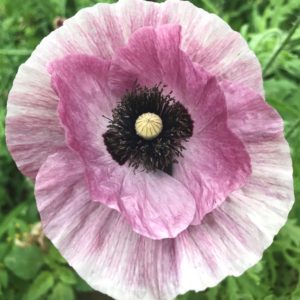Sir Cedric Morris was a twentieth-century British artist who not only painted an array of portraits and still lifes but also practiced horticultural artistry, breeding new varieties of irises and poppies. After the Second World War, he strolled through the Suffolk countryside selecting varieties that eventually became the pastel palette of dusty pinks, muted purples, and blushed whites—all with shell-like luster—that we know today as Mother of Pearl Poppy. The overall impression of a field of these poppies, grown in abundance on our farm last year, is that of an artist’s palette, one on which the colors have been gently—but unthoroughly—mixed before being applied to canvas.
When you look at Cedric Morris’s paintings, they have the feel of a specific era. For our new Mother of Pearl art pack, we envisioned artwork that would honor the transformation that takes place in all art and nature as time passes, rather than attempting to replicate a painting style of the past. No plant stands still in time and we wanted to celebrate the artistry of Sir Cedric Morris, while allowing room to play around and experiment.
We were excited to discover the paintings of artist Jean Bradbury, which feature small plants and animals in whimsical settings she calls “dreamscapes”. Often incorporating gold, silver and copper leaf, these pieces amplify the details and charm of plants to bring the wonder of nature to our attention. For her Mother of Pearl artwork, she created a cosmic array of pink and mauve blooms floating through an ethereal evening ether with a contrast shock of poppy red.
Talking about her work, Jean told us, “I paint the small things in life that fill me with wonder. I hope that in sharing this I can promote the value of the natural world and alert us to its frailty and vulnerability. Only if we learn to love nature will we learn to protect it. I like to work with children teaching botanical illustration and observation in local schools and with public art murals. I also run an organization that brings art opportunities to Syrians living as refugees in Jordan.”
 We love how you so beautifully capture the pearly, translucence of this poppy. How did you do this? "I paint in acrylic on wooden panel with many transparent washes. I started with a dark background, distressed with luscious drips and watery puddles. For a pop of excitement I used some fluorescent pink splashes. The poppies were painted by slowly building up layers of watered down white acrylic. They are delicate flowers and I wanted to capture their ephemeral nature so I emphasized their translucent quality and the thinness of the stems.
We love how you so beautifully capture the pearly, translucence of this poppy. How did you do this? "I paint in acrylic on wooden panel with many transparent washes. I started with a dark background, distressed with luscious drips and watery puddles. For a pop of excitement I used some fluorescent pink splashes. The poppies were painted by slowly building up layers of watered down white acrylic. They are delicate flowers and I wanted to capture their ephemeral nature so I emphasized their translucent quality and the thinness of the stems.
Poppies are a favorite flower of mine – precious because the flower doesn’t last long and delightful in the way they move in the slightest breeze. The best way for me to capture that was with light-hearted splashes of paint and spontaneous drips."
 Artist Jean Bradbury in front of one of her art murals.
Artist Jean Bradbury in front of one of her art murals.This poppy is such an inspiring example of the close relationship between artists, plants and nature. How do you think about the role of art in how we perceive nature and gardens?
"Most artists I know are also gardeners. We are drawn to the impossible complexity and magic of plants. I fear the world is losing its connection with nature in this digital age and I strive in my work to remind people that we are surrounded by wonder and joy. It is not just our emotional state that benefits from a connection with nature. Our very lives depend on plants and soil."
See more of Jean's work at jeanbradybury.com.
How to Grow Mother of Pearl Poppy
| Days to Maturity | 80 days |
|---|---|
| Planting Depth | 0 inches |
| Spacing in Row | 4 inches |
| Spacing Between Rows | 60 inches |
| Height at Maturity | 36 inches |
Direct sow poppies; do not transplant. Press seeds into bare, moist soil very early in the chill of spring. Keep soil moist, but not wet, especially when the days begin to warm and the soil is prone to drying out. Poppies can withstand crowding, so only thin if seedlings emerge less than 3" apart. Slow to start, but should take off once plants are 4 inches high. Mother of Pearl will bloom in several flushes and self-sows readily, so be sure to let some flowers go to seed. (Tip: to make broadcasting easier, mix seeds with sand.)














